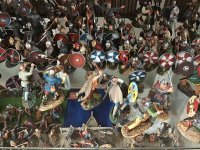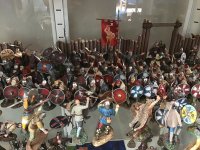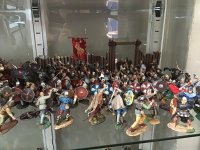- Joined
- Feb 2, 2011
- Messages
- 2,379
JJDESIGNS NEWS UPDATE 29th SEPTEMBER 2025
THE ANCIENTS
ARMIES AND ENEMIES OF GREECE AND MACEDONIA
THE ACHAEMENID PERSIAN ARMY
KARDAKE INFANTRY
Kardakes translated means “foreign mercenaries”
The Kardakes are a part of the Persian army that also appears towards the later empire, it is uncertain what they really were. Some say that they were mercenaries, others that they were influenced by the Greek Hoplites and that we should assume that they were a Persian attempt to reform the army in a Greek way.

The Kardakes are described by historians as "Hoplites", Slingers and "Peltasts". This may illustrate that Kardakes most likely were not a specific troop type, like a heavy infantryman or a skirmisher but rather a specific group which supplied several kinds of soldiers.
This means that the Kardakes would have been equipped differently. At the battle of Issus Arrian calls them Hoplites, and Kallisthenes as Peltasts.


The Kardaka infantryman are based on the Alexander mosaic. Greek hoplite shields are shown as plain bronze, and the others are painted. It is believed that the yellow hooded troops were Persians, although it is also proposed that these could also have been non ethnical Persians. They were believed to have been accorded the status of a Persian bondsman in return for their military service.
This would have entitled them to exemption from taxes, a privilege reserved for the Persians, and perhaps the right to be tried according to Persian law. Therefore it is speculated that the yellow hood may have been the badge of one holding Persian legal status.

If we assume the assumptions concerning the yellow hoods are correct, then it is proposed that the white hoods represent troops of non-Iranian origins.
KARDAKE LIGHT INFANTRY
There has always been some debate over the armament and how the Kardakes were employed as a fighting force. As previously mentioned several historians have described them as peltasts.
Modern scholars seem to deduce from this that there was an attempt to produce a native Persian close fighting infantry to support the mercenary Greek hoplite, and Kardakes Hoplites, against the Macedonian phalanx.

Xenophon describes the Kardakes as carrying two javelins, and using a Kopis or a Sagaris ( the bronze pick-like Saka battleaxe, which was adopted by the Persians) and a wicker shield. It is also confirmed that many would also have used bows.
The Alexander sarcophagus shows Persian infantry not only carrying Hoplite shields, but many with crescent shaped shields similar to the Greek peltai.

Adding support to the recent Kardake Light Infantry will be some new Achaemenid Persian slingers.
Xenophon records the slings shot stones “as big as one’s fist” but which had only half the range of the smaller Rhodian lead sling-bullets.
Later Macedonian and Seleucid Kyrtii slingers, which escorted their elephants were in similar dress.
PLEASE NOTE THE KARDAKE HOPLITE INFANTRY WILL BE AVAILABLE IN THE NEW YEAR.
Best wishes,
john jenkins
THE ANCIENTS
ARMIES AND ENEMIES OF GREECE AND MACEDONIA
THE ACHAEMENID PERSIAN ARMY
KARDAKE INFANTRY
Kardakes translated means “foreign mercenaries”
The Kardakes are a part of the Persian army that also appears towards the later empire, it is uncertain what they really were. Some say that they were mercenaries, others that they were influenced by the Greek Hoplites and that we should assume that they were a Persian attempt to reform the army in a Greek way.

The Kardakes are described by historians as "Hoplites", Slingers and "Peltasts". This may illustrate that Kardakes most likely were not a specific troop type, like a heavy infantryman or a skirmisher but rather a specific group which supplied several kinds of soldiers.
This means that the Kardakes would have been equipped differently. At the battle of Issus Arrian calls them Hoplites, and Kallisthenes as Peltasts.


The Kardaka infantryman are based on the Alexander mosaic. Greek hoplite shields are shown as plain bronze, and the others are painted. It is believed that the yellow hooded troops were Persians, although it is also proposed that these could also have been non ethnical Persians. They were believed to have been accorded the status of a Persian bondsman in return for their military service.
This would have entitled them to exemption from taxes, a privilege reserved for the Persians, and perhaps the right to be tried according to Persian law. Therefore it is speculated that the yellow hood may have been the badge of one holding Persian legal status.

If we assume the assumptions concerning the yellow hoods are correct, then it is proposed that the white hoods represent troops of non-Iranian origins.
KARDAKE LIGHT INFANTRY
There has always been some debate over the armament and how the Kardakes were employed as a fighting force. As previously mentioned several historians have described them as peltasts.
Modern scholars seem to deduce from this that there was an attempt to produce a native Persian close fighting infantry to support the mercenary Greek hoplite, and Kardakes Hoplites, against the Macedonian phalanx.

Xenophon describes the Kardakes as carrying two javelins, and using a Kopis or a Sagaris ( the bronze pick-like Saka battleaxe, which was adopted by the Persians) and a wicker shield. It is also confirmed that many would also have used bows.
The Alexander sarcophagus shows Persian infantry not only carrying Hoplite shields, but many with crescent shaped shields similar to the Greek peltai.

Adding support to the recent Kardake Light Infantry will be some new Achaemenid Persian slingers.
Xenophon records the slings shot stones “as big as one’s fist” but which had only half the range of the smaller Rhodian lead sling-bullets.
Later Macedonian and Seleucid Kyrtii slingers, which escorted their elephants were in similar dress.
PLEASE NOTE THE KARDAKE HOPLITE INFANTRY WILL BE AVAILABLE IN THE NEW YEAR.
Best wishes,
john jenkins




